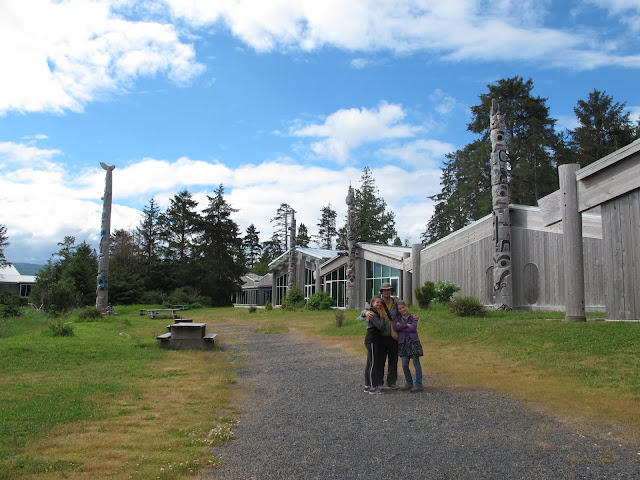Prince Report & Haida Gwaii
June 5, 2019
Prior to boarding the ferry for Haida Gwaii we went out for Vietnamese food in Prince Rupert followed by ice cream. It turned out we were on the same ferry vessel again, the Northern Adventure. This time we had a berth with 4 bunks and a little washroom that even had a shower. We left after midnight (sail time was scheduled for 10pm) and arrived at 7am, an hour late.
We drove 10 minutes to Kagan Bay Recreational Area for breakfast and hot bevies made on our Coleman stove. The area had beach and was beautiful. Next up was the Haida Gwaii Museum. Little note: the Haida people have called these islands Haida Gwaii since forever (meaning Islands of the People) until the colonists renamed it something that rolls off the tongue more easily for the white man: The Queen Charlotte Islands. In 2010 there was an official “Giving back the name” ceremony during which the Haida nation wrote the old inbred royal’s name on a piece of paper and placed it in a traditional bentwood box and handed it to the BC premier. A rare minus one point (loss) for the white team.
The museum was fantastic. My only complaint is that photography is not allowed in the indoor part and it is hard to remember so many of the things I saw. Briefly:
- The Haida language requires more than just a mouth with a tongue and vocal chords. The stomach is involved as well as the entire body since there’s some shaking involved and other subtle body language stuff. There was only a hand full of surviving Haida that spoke the language thanks to extremely effective Potlatch laws (with residential schools thrown in for good measure). A potlatch was a band celebration/meeting/ party that was at the core of being Haida and these were banned (up to 6 months jail) for decades by the white team. Anyway, those that were fluent in Haida have been teaching children and adults recently and hundreds of CDs for teaching the language have been made and distributed.
- Most people know that cedar bark can be used to make baskets, but cedar root is also used to make intricate weavings. The process is extremely time demanding since the roots have to be dug up, sorted according to size, stripped to the size needed, and so on. See the book Braiding Sweet Grass by Kimmerer for more detail.
- The Haida made some pretty cool totem poles, many were on display.
- They made nice canoes.
- The last part of the museum is the white man section and includes things like typewriters and telegraph gear. There I found a photo album with a picture of Pierre Trudeau holding Justin in his arms. It was taken in 1976 on Haida Gwaii during the opening ceremony for what was then known as the Queen Charlotte Museum, the predecessor to where I was now. I figured it wasn’t disrespectful in this part of the museum to snap a pic of it and so I did.
Next we headed to Naikoon Provincial Park Misty Gardens campground for the next 2 nights. After lunch it started to pour so we hung out and had a fire in the day use picnic shelter using the old iron wood-burning fireplace that was there.
At about 7:30pm a park ranger came collecting money as per the posted sign. This was a first, no attendant on duty or self-pay system, instead the sign said “Someone will come by and collect camping fee.”
Today we hiked the 5 km out to see the Pesuta shipwreck which ran aground during a bad storm in 1928. The first 3 km of the hike was in beautifully moss carpeted forest. The last 2 km was along a river leading to the ocean. At first this river appeared to be lined with perfect weed-free uniformly cut grass. Then I saw a jelly fish on the grass and realized it was seaweed. How very kind of B.C. Parks to schedule not only the rain outside of our hike time but also to set up the tide so that it would be low tide during our hike. Come to think of it, there was a note on the sign board at the trailhead telling you to check the not-posted tide charts to ensure you didn’t get stuck and unable to return (I had little interest in this because my shoes had spent the night outside in the rain and were still wet (and likely won’t be drying anytime soon since I’m wearing them) and if I had to walk in ankle-deep or even knee-deep water for that matter (my pants hadn’t quite dried yet from yesterday’s downpour either) my level of discomfort would not appreciably change).
The shipwreck itself was pretty cool and an excellent opportunity to catch tetanus if one was so inclined. We had lunch and left as the rocks-lined-up- on-the-beach-o-meter was indicating the tide was coming in (they were swallowed up by the ocean after only a short while) and the perfect golf course grass would soon by getting salt-watered.
Another thing regarding the Haida People I almost forgot to mention: They were entirely woman-run. Matriarchal, not patriarchal. How shocking this must have been for the white man when he showed up.
 |
| The Pesuta shipwreck. |
 |
| Diorama at the Haida Gwaii Museum. |
 |
| Canoes of the Haida people. |
 |
| Behind Lucy and Miriam is Alaska! |
 |
| This beach was fantastic for looking for agate rocks. It is called Agate Beach. |
 |
| Totems at the Haida Gwaii Museum. |
Comments
Post a Comment